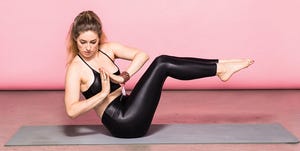Unicorn-status joys in life: Grabbing the last treadmill at the gym, snagging a Kylie lip kit in the millisecond before they sell out, and finding a core move that *actually* works those impossible-to-hit lower abs.
“It’s so important to have a well-rounded core program,” says Hayley Urfer, trainer and boxing instructor at Everybody Fights in Lexington, Kentucky. “And reverse crunches are a great addition to any routine since they build strength in the lower abdominal region—a tough part of the body to target.”
How To Do A Reverse Crunch
How to: Lie on your back, arms by your side with palms facing down to help create balance needed for the lift. Bend your knees at 90 degrees and lift your feet up so your thighs are perpendicular to the floor. Pressing into your palms and engaging your core, lift your hips off the floor as you crunch your knees toward your chest. Hold the crunch at the top of the movement, then begin to lower your hips, controlling the descent and not letting your back arch off the ground. That’s one rep.
“Reverse crunches build strength in the lower abdominal region—a tough part of the body to target.”
Form tips: Focus on tucking your pelvis inward (think: belly button towards spine), which will naturally pull your knees to your chest while lifting your hips off the ground, says Urfer. And go slow, so that you use your core muscles (rather than momentum). Urfer also says you should keep your neck firmly planted on the ground throughout the whole exercise to avoid strain.
Reps/sets you should do to see results: Aim for 2 to 3 sets of 8 to 10 reps, adding more reps, resistance, or time under tension as your core gets stronger.
Benefits Of Reverse Crunch
Yes, the reverse crunch is clutch for toning those lower abs. But beyond that, this move works the entire rectus abdominis region—the large muscle group that runs down the middle of your abdomen, from the bottom of the rib cage to the top of the pelvis.



Additionally, the reverse crunch challenges your obliques and transverse abdominals, those deep muscles that build true core strength. In other words: This move hits every muscle you need to carve out a six pack, says Urfer.
But the reverse crunch is even more important for function than aesthetics, Urfer adds. “Core strength and endurance are very important to stabilize the body and avoid injury in any type of lifting movement, as well as everyday activities,” she explains. The reverse crunch is a staple for building not just lower core strength, but also strength for more complex movements like deadlifts and loaded squats.
Make Reverse Crunch Part Of Your Workout
Like all core exercises, you can work reverse crunches into your routine every day if you want, says Urfer. She particularly likes using this move as a warm up for other exercises such as squat, deadlift, or rowing. “Activating your core is crucial to preventing injury when working out,” she explains. “It helps prevent your low back from taking over.”
If a classic reverse crunch isn’t quite challenging enough, make it harder by extending your legs from 90 degrees to straight up in the air, then lift.
Another option is pairing a reverse crunch with moves that target other parts of the abs for a total-core workout. Try adding bicycle crunches to light up your upper abs, plus stability movements like planks, side planks, and farmer’s carries.
Most important: Focus on the quality of the movement over quantity. So, yes, you should feel a burn.
Source: Read Full Article
